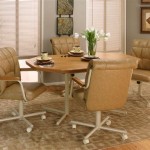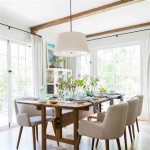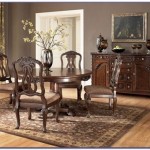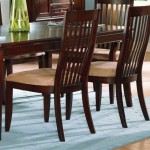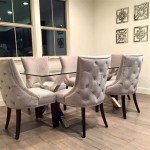Dining Room Table Set Up Ideas
The dining room table serves as a focal point for communal meals, celebrations, and everyday interactions. As such, the arrangement and presentation of the table profoundly influence the atmosphere and perceived enjoyment of the dining experience. Exploring diverse setup ideas can transform the dining room from a purely functional space into an inviting and stylish environment.
A well-considered table setting goes beyond mere practicality; it reflects personal style, enhances the visual appeal of the food, and sets the tone for the gathering. This article will delve into various dining room table setup ideas, encompassing different styles, occasions, and considerations to assist in creating a memorable and aesthetically pleasing dining space.
Understanding Foundational Elements
Before delving into specific table setting arrangements, it is crucial to establish a strong understanding of the fundamental elements that comprise a cohesive and functional dining table setting. These elements include placemats, linens, dinnerware, glassware, cutlery, and centerpieces. Each component plays a crucial role in the overall design and functionality of the table.
Placemats, typically rectangular or round, protect the table surface from spills and heat damage while also adding a layer of visual interest. They define individual place settings and contribute to the overall aesthetic. Linens, encompassing tablecloths, runners, and napkins, introduce texture and color to the table. A tablecloth provides a comprehensive base, while a runner adds a decorative element down the center of the table. Napkins, available in various materials and folds, serve both a practical and decorative purpose.
Dinnerware, consisting of plates, bowls, and side plates, is the most essential element of any table setting. The choice of dinnerware material, shape, and color should complement the overall style of the dining room and the occasion. Glassware, including water glasses, wine glasses, and other beverage glasses, enhances the dining experience and adds a touch of elegance. The selection of glassware should be appropriate for the beverages being served.
Cutlery, comprised of forks, knives, and spoons, should be arranged according to proper etiquette, with forks placed to the left of the plate and knives and spoons to the right. The specific cutlery items used will depend on the menu being served. Centerpieces, ranging from floral arrangements to sculptural objects, serve as the visual anchor of the table setting. They should be proportionate to the size of the table and should not obstruct sightlines across the table.
Exploring Different Table Setting Styles
Different table setting styles cater to various occasions and personal preferences. Understanding the nuances of each style allows for the creation of a dining experience that is both appropriate and aesthetically pleasing. Three common table setting styles are formal, informal, and casual.
A formal table setting is characterized by its meticulous arrangement and adherence to traditional etiquette. It is typically reserved for special occasions such as holidays, anniversaries, or formal dinners. A formal setting includes a tablecloth, placemats, charger plates (underplates), dinner plates, salad plates, soup bowls, bread plates, and butter knives. Multiple forks, knives, and spoons are arranged according to the order in which they will be used. Numerous glasses are present, including water glasses, wine glasses (red and white), and possibly champagne flutes. A centerpiece is typically elaborate and elegant, such as a large floral arrangement or a candelabra. The overall impression is one of sophistication and refinement.
An informal table setting is a less elaborate version of the formal setting. It is suitable for dinner parties, family gatherings, and other semi-formal occasions. It typically includes a placemat or bare table, a dinner plate, a salad plate (optional), a bread plate (optional), a fork, a knife, a spoon, a water glass, and a wine glass (optional). The centerpiece is simpler than in a formal setting, perhaps consisting of a small vase of flowers or a few candles. The overall impression is one of relaxed elegance.
A casual table setting is the simplest and most relaxed style. It is appropriate for everyday meals and informal gatherings. It typically includes a placemat or bare table, a dinner plate, a fork, a knife, a spoon, and a water glass. Napkins can be paper or cloth, and the centerpiece is often omitted or kept very simple. The overall impression is one of comfort and functionality.
Considering Themes and Color Palettes
Beyond the basic elements and styles, themes and color palettes significantly influence the overall ambiance of the dining room table setting. A well-chosen theme can add a unique touch to the dining experience, while a cohesive color palette ties all the elements together.
Themes can be inspired by various sources, such as seasons, holidays, or specific interests. A spring-themed table setting might incorporate pastel colors, floral patterns, and natural elements like branches and leaves. A holiday-themed table setting could feature traditional colors, festive ornaments, and thematic centerpieces. Alternatively, a theme could be based on a particular cuisine or culture, such as a Mediterranean-themed table setting with vibrant colors, terracotta pottery, and olive branches.
The choice of color palette is equally important. A monochromatic color scheme, using different shades of a single color, creates a sophisticated and harmonious look. A complementary color scheme, using colors opposite each other on the color wheel, adds vibrancy and contrast. An analogous color scheme, using colors that are adjacent to each other on the color wheel, creates a calming and harmonious effect. When selecting a color palette, consider the existing colors in the dining room and the overall mood you wish to create.
Using textures is also crucial to bring variety to the setting. The textures of linens, dinnerware and decorative objects can provide depth and interest, and keep the setting from appearing too flat or one-dimensional.
Incorporating Centerpieces and Decorative Accents
Centerpieces serve as the focal point of the dining room table setting, drawing the eye and setting the tone for the meal. Decorative accents, placed strategically around the table, further enhance the overall aesthetic and add personality to the space.
Centerpieces can range from simple floral arrangements to elaborate sculptural displays. The choice of centerpiece should be proportionate to the size of the table and should not obstruct sightlines across the table. When selecting a floral arrangement, consider the color palette and style of the table setting. A formal table setting might call for a large and elegant floral arrangement, while a casual table setting might benefit from a simple vase of wildflowers.
Other centerpiece options include candles, fruit bowls, decorative objects, and seasonal displays. Candles add warmth and ambiance to the dining experience, especially during evening meals. Fruit bowls offer a touch of natural beauty and can be arranged to complement the color palette of the table setting. Decorative objects, such as sculptures, figurines, or antique pieces, add personality and visual interest. Seasonal displays, such as pumpkins in the fall or ornaments during the holidays, create a festive atmosphere.
Decorative accents can include place card holders, napkin rings, individual salt and pepper cellars, and small trinkets. Place card holders add a personal touch to the table setting and can be customized to match the theme. Napkin rings add a touch of elegance and can be chosen to complement the dinnerware. Individual salt and pepper cellars provide convenience and add a touch of sophistication. Small trinkets, such as seashells, pebbles, or miniature figurines, can be scattered around the table to add a playful and whimsical touch.
Integrating natural elements, such as greenery, branches, or stones, can bring a sense of the outdoors into the dining room. These elements can be incorporated into the centerpiece or scattered around the table as decorative accents.
Addressing Practical Considerations
While aesthetics are important, practical considerations should not be overlooked when setting up a dining room table. The table setting should be functional, comfortable, and conducive to a pleasant dining experience.
Ensure that there is adequate space between place settings to allow diners to eat comfortably. A general guideline is to allow at least 24 inches of space per diner. The height of the chairs should be appropriate for the height of the table, allowing diners to sit comfortably and reach their plates easily. The tablecloth or placemats should be the correct size for the table, providing adequate coverage without being too long or too short.
Cutlery should be arranged according to proper etiquette, with forks placed to the left of the plate and knives and spoons to the right. The specific cutlery items used should be appropriate for the menu being served. Glassware should be placed within easy reach of each diner. Water glasses should be filled before diners are seated, and wine glasses should be filled as needed. Napkins should be placed either to the left of the fork or on the plate. Salt and pepper shakers should be readily available to all diners. Consider placing smaller salt and pepper servers at each place setting for added convenience.
Lighting plays a crucial role in the ambiance of the dining room. Overhead lighting should be adjustable to allow for different levels of brightness. Candles or decorative lamps can be used to add warmth and ambiance to the table setting. The centerpiece should not obstruct sightlines across the table, allowing diners to easily converse with each other.
Finally, consider the overall flow of the dining room. Ensure that there is ample space for servers to move around the table and that there are no obstructions that could impede their movement. Consider the placement of serving dishes and utensils to ensure they are easily accessible without cluttering the table.

3 Simple Table Setting Ideas Pops Of Color Home

15 Dining Room Table Decor Ideas For A Perfect Tablescape

Ideas For Setting A Neutral Fall Table Sanctuary Home Decor

15 Trending Dining Room Decor Ideas You Can T Miss

5 Budget Ideas To Transform Your Dining Room

Trendy Modern Dining Room Decorating Ideas 2025 Table Home Interior Design Tips Trends

16 Modern Dining Table Centerpieces You Can Use Year Round

41 Fall Dining Room Table Decor Ideas Edward George

How To Set The Table For Any Occasion Grain Frame

Centerpieces And Table Decors Capture Fall S Beauty

